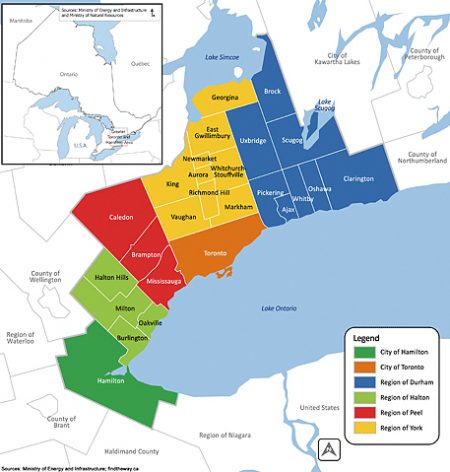July 2, 2108 – If you have never heard of The Atmospheric Fund (TAF) I’m not surprised. It seems to be a well-guarded secret here in the Greater Toronto and Hamilton Area (GTHA) of Southern Ontario, an area with a population of over 7.25 million.

TAF’s mission is to provide funding grants to initiatives in the area from community leaders, developers, property owners, and entrepreneurs with a goal to shrink the collective GTHA carbon footprint, a target reduction of 80% by 2050. In its latest report which can be accessed by clicking on this link, TAF provides four pathways for a successful low-carbon energy transition.
How can TAF help Canada’s largest urban area, the GTHA, achieve what is needed to mitigate and adapt to climate change?
- By slashing energy waste which would contribute to 1/3 of our emission reduction goal through improved efficiency.
- By continuing the transformation to a carbon-free electricity grid.
- By reducing the use of fossil-fuel sourced energy, substituting cleaner fuels including biofuels and biogas for transportation, heating, cooling, and industrial processes.
- By shrinking the greenhouse gas emissions and carbon footprint of fossil fuels produced by Canada’s oil and gas industry which then get transported and burned within the GTHA.
These are ambitious directives that need to be fleshed out to become policy with accountable actions. The transition to a low-carbon GTHA which today produces close to 7% of Canada’s total greenhouse gas emissions, can become a model for other large cities in the country as well as around the world. The getting there requires more than broad principles but instead a societal transformation that will change the look of the GTHA and Canada as the century unfolds.
Just how so?
Consider what a Canadian home will look like a generation from now. Inside the home will be smart, energy-efficient appliances, smart sensors, windows, and lighting. The roofs will be solar producing much of the electricity needed for the home. Instead of getting power from a national grid, neighbourhood microgrids will supplement home needs through a variety of energy technologies, from modular nuclear standalone systems producing no radioactive waste, to grid-scale solar and battery storage, to gas-power generators equipped with carbon capture and reuse technology, to wind turbines, and in the event of any or all of the above failing to meet the need, access to the legacy national grid with power coming from hydroelectric sources.
In the GTHA, where apartments and condominiums serve the largest number of residents, building cluster will have their own microgrid drawing energy needs from the same types of power sources described above plus utilizing waste heat from subterranean urban sources. Buildings that are net positive energy producers will be able to sell excess power to neighbouring buildings and pass the money earned to residents.
In this new environment, all new apartments and condominiums will have a low-carbon energy design while legacy buildings will be given grants or low-interest loans from the government to do retrofits to meet the new standards. The obvious incentive to do this will exist because it will save these older buildings from having to purchase energy from their newer neighbours. All new buildings will be mandated to include charge stations for every parking space. Older buildings will be required to phase in retrofits to install similar EV infrastructure.
Today the GTHA concentrates much of its business within city cores whether it is Toronto, Hamilton, Mississauga, Brampton, or any of the other municipalities that constitute the area. The daily commutes to and from work are significant contributors to carbon emissions particularly when the mode of transportation is the single-family vehicle. Traffic congestion has made the GTA the slowest commute in North America. Every year more than 100,000 single-family vehicles get added to the traffic.
In a generation from now, this urban transit pattern will be gone with something that will look far different. For those who choose the single-family vehicle route to work, every time they drive in peak periods they will pay congestion charges. Many high-density roads will be tolled. Autonomous vehicles will be on city streets leading to a fleet of on-demand vehicles resulting in fewer drivers using their own means of transport. More commuters will use public transit as the government makes significant investments in elevated or right-of-way light rail, subways, streetcars and buses with funding coming from tolls, congestion charges and other direct and indirect taxes for urban-located single-family vehicle taxes. Rural single-family vehicles will only be subject to tolls and congestion charges when coming into the city, but will not pay those direct and indirect taxes for ownership of a single-family vehicle.
Microgrid clusters will be the main source of power for businesses and industry and will evolve similarly to the apartment and condominium model described above. And more businesses will have virtual addresses with employees doing virtual commutes lessening urban traffic even more. And for those industries where manufacturing will require a large on-site labour component, the technology to be energy self-sufficient will produce enormous operational cost savings, even contributing positively to the bottom line.
Upgrades to urban infrastructure will include waste heat capturing technology produced from underground transit and sewer systems. This heat will be captured and pumped into buildings to supplement heating using other energy sources. Greywater capture and reuse will reduce freshwater consumption and the amount of energy required to pump and store this volume in GTHA reservoirs.
Here are just some of the efficiency milestones that TAF has set to help in the transition to a lower-carbon economic model. These are stated as nationwide goals.
For industrial transportation
- by 2030 a shift to rail over truck for long-distance transport.
- by 2030 improve the fuel efficiency of truck fleets to meet or exceed best-in-clean standards worldwide.
- by 2030 to make it mandatory for most ships visiting Canadian ports to plug into local power sources while dockside.
For personal transportation
- by 2040 to see single passenger-in-vehicle trips halved in medium and large cities across the country.
- by 2030 to see 30% of all new vehicle sales to be electric
- by 2030 to have a national charging network in place coast-to-coast.
For public transportation
- by 2025 to have all forms of mass transit converted to zero-emission technology.
For buildings
- by 2040 to implement a net-zero energy code for all new construction.
- by 2040 to ensure that all homes and buildings meet leading cold-climate energy requirements.
- by 2025 to require all homes and buildings list energy performance to prospective buyers and renters.
- by 2050 require all commercial and institutional buildings with appropriate roof areas and orientation to install solar panels.
For industry
- by 2030 to see 75% of the industrial use of energy managed by smart systems.
For energy
- by 2030 to have 90% of all electricity produced from non-emitting sources, and by 2050 to have 100% produced from non-emitting sources.
- by 2030 to make carbon capture and sequestration commercially viable for large and small-scale energy producing installations.
- by 2040 establish hydrogen and fuel cell technology to supplement other net-zero energy infrastructure and establish a business model for its global export.
- by 2030 reduce nationwide greenhouse gas emissions by 30 million tons annually.
- by 2025 reduce methane emissions by 45% from existing oil and gas production sites.
- by 2030 reduce greenhouse gas emissions from oil sands extraction and production to levels lower than other sources of crude oil in the global market.
And finally, to ensure that these goals can be met, to develop and implement by 2020 a measuring, monitoring and reporting system that is transparent to all Canadians so that they may be active participants in meeting the many objectives and goals described above.










